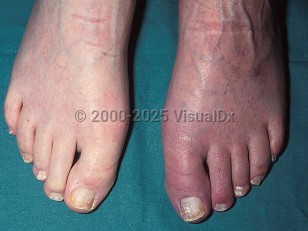Ergotism
Alerts and Notices
Important News & Links
Synopsis

Ergotism can take two forms: convulsive (neurologic) and gangrenous (ischemic). Convulsive ergotism shares many clinical features with serotonin syndrome, while gangrenous ergotism is a form of dry gangrene due to vasoconstriction, most often of the lower limbs. While both forms existed in epidemics historically, modern ergotism is usually related to chronic toxicity from overuse of ergotamine alkaloids and typically takes the "gangrenous" (ischemic) form. Acute ergotism, although less common, can present with signs and symptoms of both convulsive and gangrenous forms.
In both convulsive and gangrenous ergotism, the initial symptoms consist of gastrointestinal disturbances, vague flu-like symptoms, and distal extremity paresthesias. In the convulsive type, the disorder then progresses to involuntary, spastic movements, opisthotonus, hallucinations, mental status changes, seizures, and even death. Symptoms can be episodic with short periods during which the patient seems unaffected.
In the gangrenous form of modern ergotism, patients are mentally intact, and peripheral vasculature is the target of the disorder, due to alpha-adrenergic stimulation. Symptoms are typically claudication and a burning sensation in the lower limbs, decreased distal pulses, and skin that is cool to the touch with a bluish discoloration in severe cases.
Perianal ulcers and even anorectal strictures and rectovaginal fistulas have been reported in association with ergotamine tartrate suppositories, which are used for migraines. Ergotamine-induced perianal ulcers are typically painless and clear up with the cessation of the medication. Local vasoconstriction is the presumed cause.
Codes
T62.94XA – Toxic effect of unspecified noxious substance eaten as food, undetermined, initial encounter
SNOMEDCT:
51510002 – Ergotism
Look For
Subscription Required
Diagnostic Pearls
Subscription Required
Differential Diagnosis & Pitfalls

Subscription Required
Best Tests
Subscription Required
Management Pearls
Subscription Required
Therapy
Subscription Required
Drug Reaction Data
Subscription Required
References
Subscription Required

